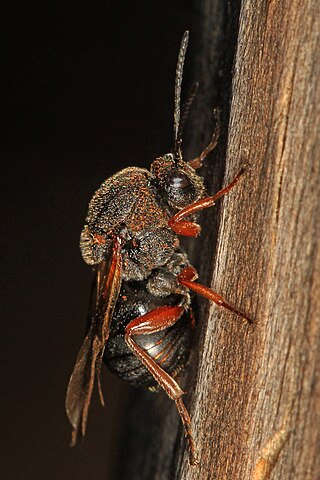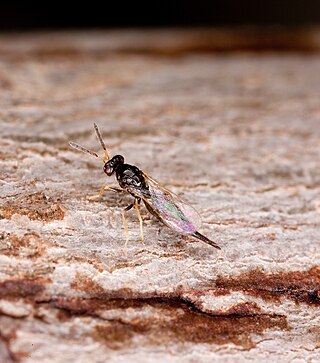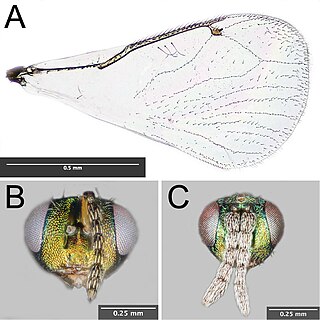
Chalcid wasps are insects within the superfamily Chalcidoidea, part of the order Hymenoptera. The superfamily contains some 22,500 known species, and an estimated total diversity of more than 500,000 species, meaning the vast majority have yet to be discovered and described. The name "chalcid" is often confused with the name "chalcidid", though the latter refers strictly to one constituent family, the Chalcididae, rather than the superfamily as a whole; accordingly, most recent publications (e.g.,) use the name "chalcidoid" when referring to members of the superfamily.

In evolutionary ecology, a parasitoid is an organism that lives in close association with its host at the host's expense, eventually resulting in the death of the host. Parasitoidism is one of six major evolutionary strategies within parasitism, distinguished by the fatal prognosis for the host, which makes the strategy close to predation.

Apocrita is a suborder of insects in the order Hymenoptera. It includes wasps, bees, and ants, and consists of many families. It contains the most advanced hymenopterans and is distinguished from Symphyta by the narrow "waist" (petiole) formed between the first two segments of the actual abdomen; the first abdominal segment is fused to the thorax, and is called the propodeum. Therefore, it is general practice, when discussing the body of an apocritan in a technical sense, to refer to the mesosoma and metasoma rather than the "thorax" and "abdomen", respectively. The evolution of a constricted waist was an important adaption for the parasitoid lifestyle of the ancestral apocritan, allowing more maneuverability of the female's ovipositor. The ovipositor either extends freely or is retracted, and may be developed into a stinger for both defense and paralyzing prey. Larvae are legless and blind, and either feed inside a host or in a nest cell provisioned by their mothers.

Casuarina, also known as she-oak, Australian pine and native pine, is a genus of flowering plants in the family Casuarinaceae, and is native to Australia, the Indian subcontinent, Southeast Asia, islands of the western Pacific Ocean, and eastern Africa.

Gall wasps, also traditionally calledgallflies, are hymenopterans of the family Cynipidae in the wasp superfamily Cynipoidea. Their common name comes from the galls they induce on plants for larval development. About 1,300 species of this generally very small creature are known worldwide, with about 360 species of 36 different genera in Europe and some 800 species in North America.

The Braconidae are a family of parasitoid wasps. After the closely related Ichneumonidae, braconids make up the second-largest family in the order Hymenoptera, with about 17,000 recognized species and many thousands more undescribed. One analysis estimated a total between 30,000 and 50,000, and another provided a narrower estimate between 42,000 and 43,000 species.

The Mymaridae, commonly known as fairyflies or fairy wasps, are a family of chalcidoid wasps found in temperate, subtropical, and tropical regions throughout the world. The family contains around 100 genera with 1,400 species.

Parasitoid wasps are a large group of hymenopteran superfamilies, with all but the wood wasps (Orussoidea) being in the wasp-waisted Apocrita. As parasitoids, they lay their eggs on or in the bodies of other arthropods, sooner or later causing the death of these hosts. Different species specialise in hosts from different insect orders, most often Lepidoptera, though some select beetles, flies, or bugs; the spider wasps (Pompilidae) exclusively attack spiders.

The Eucharitidae are a family of parasitic wasps. Eucharitid wasps are members of the superfamily Chalcidoidea and consist of three subfamilies: Oraseminae, Eucharitinae, and Gollumiellinae. Most of the 55 genera and 417 species of Eucharitidae are members of the subfamilies Oraseminae and Eucharitinae, and are found in tropical regions of the world.

A wasp is any insect of the narrow-waisted suborder Apocrita of the order Hymenoptera which is neither a bee nor an ant; this excludes the broad-waisted sawflies (Symphyta), which look somewhat like wasps, but are in a separate suborder. The wasps do not constitute a clade, a complete natural group with a single ancestor, as bees and ants are deeply nested within the wasps, having evolved from wasp ancestors. Wasps that are members of the clade Aculeata can sting their prey.

Leptocybe invasa, the blue gum chalcid wasp or eucalyptus gall wasp, is a chalcid wasp which is the only species in the monotypic genus Leptocybe in the subfamily Tetrastichinae, of the family Eulophidae. It is a gall wasp which causes the formation of galls on a number of species of Eucalyptus, it was described in 2004 after galls were found in river red gums in the Mediterranean and Middle East and has since been found to be a widespread species where its host trees are planted. It is indigenous to Australia.

Quadrastichus is a genus of hymenopteran insects of the family Eulophidae.

Dryocosmus kuriphilus is a species of gall wasp known by the common names chestnut gall wasp, Oriental chestnut gall wasp, and Asian chestnut gall wasp. It is native to China and it is known in many other parts of the world, particularly the Northern Hemisphere, as an introduced species and an invasive horticultural pest. It attacks many species of chestnut, including most cultivated varieties. It is considered the world's worst pest of chestnuts.

Quadrastichus erythrinae Kim, 2004, is a small parasitoid wasp belonging to the family Eulophidae, but also a secondary phytophage by way of inducing galls on the leaves, stems, petioles and young shoots of various Erythrina species.
Anaphes nitens is a species of fairyfly, a chalcid wasp in the family Mymaridae. Native to Australia, it is an egg parasitoid of the gum tree snout beetle, a pest of Eucalyptus trees, and has been used in biological pest control of that species.

Tetrastichinae is a subfamily of the chalcid wasp family Eulophidae. It is one of the largest subfamilies of the Eulophidae containing over 100 genera and nearly 3,000 species. The species of the family Tetrastichinae are found in almost any type of terrestrial habitat and have a worldwide distribution, except Antarctica. They show a varied biology and hosts for Tetrastichinae wasps have been identified from over 100 different insect families, across 10 different orders and they have also been recorded as being parasitoids on nematodes, mites and spiders' eggs. Some species are even phytophagous, while others are inquilines and yet others are gall formers.

Euderus set, the crypt-keeper wasp, is a tiny chalcid wasp from the family Eulophidae from the United States, described in 2017 as a parasitoid of the gall wasp Bassettia pallida. The description of its life cycle has attracted widespread publicity.
Epichrysocharis burwelli, the lemon scent eucalyptus gall wasp, is a species of gall wasp from the family Eulophidae which was first described from California in 2000 but which is thought to have originated in Australia, where its host plant is indigenous. It is now found in many areas of the World where its host plant, the lemon-scented eucalyptus Corymbia citriodora is grown.
Leprosa milga is a species of Afrotropical wasp in the family Eulophidae, the only member of the genus Leprosa. It is a gall wasp which induces the production of galls on the seed pods of species in the genus Eucalyptus. It probably originated in Australia but has been recorded from South Africa and Italy.
Selitrichodes is a genus of hymenopteran insects of the family Eulophidae, most of which are parasitoids associated with gall producing insects on Eucalyptus.
















